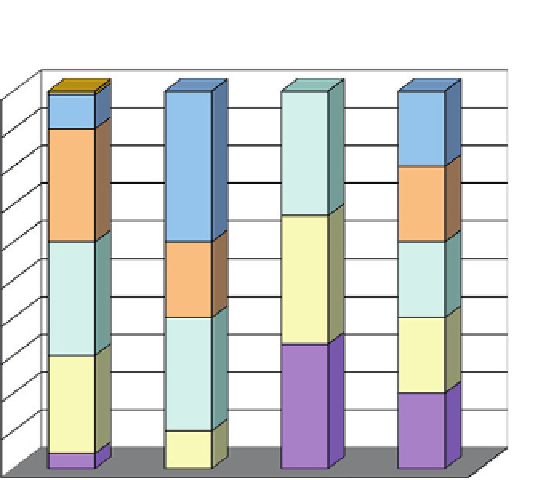Environmental Engineering Reference
In-Depth Information
Bioturbation
6
100%
5
5
90%
3
5
80%
4
4
70%
60%
4
2
3
50%
3
40%
2
30%
3
20%
2
1
1
10%
2
1
0%
Reineck
(1963) and
Taylor and
Goldring
(1993)
Droser and
Bottjer
(1986), Miller
and Smail
(1997), and
Montague
et al. (2010)
Lockley
(1991)
Rebata-H.
et al. (2006),
this chapter
FIGURE 2
Comparison of various classification systems to quantify the degree or index of bio-
turbation. Established systems use unequal proportions in each category, whereas an equal distri-
bution of categories should be preferred for statistical analysis.
of organic compounds may reveal their internal fabric by staining using the peri-
odic acid-Schiff reaction (
Risk and Szczuczko, 1977
), marly chalk or limestone
samples are best studied after staining with oil (
Bromley, 1981; Ol´riz and
Rodr
´
guez-Tovar, 2002
), whereas cherts and siliceous rocks can be etched using
hydrofluoric acid (
Kakuwa, 2004
).
Peels can be retained from polished rock surfaces of different chemical com-
position, and continuous grinding and peeling may produce serial sections
(
Miller, 1988
). Carbonates, for instance, can be etched with hydrochloric or for-
mic acid, dried, and subsequently treated with acetone before being covered with
a transparent film for replication (
Fig. 3
). Further, serial sectioning is a powerful
technique to reveal the three-dimensional nature of trace fossils and has been suc-
cessfully applied in many studies (
Bednarz and McIlroy, 2009; Michal
´
kand
ˇ
imo, 2010; Mil
´
n and Bromley, 2006; Naruse and Nifuku, 2008; Retallack,
2001
). It is an advanced technique commonly applied in biology and medicine,
and specific software applications help to process the data in order to reconstruct
the three dimensions of the object under investigation (e.g.,
Fiala, 2005
).

























Search WWH ::

Custom Search